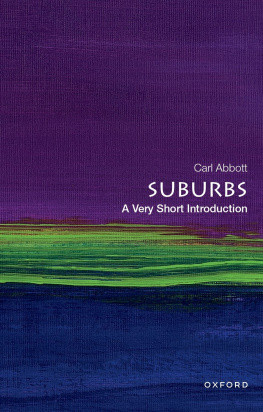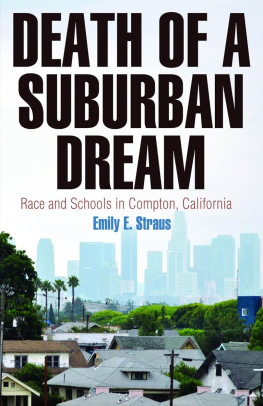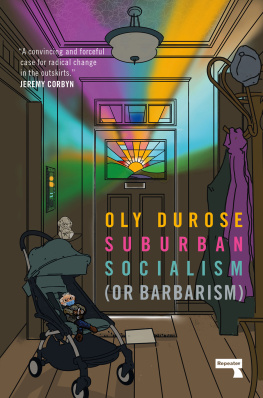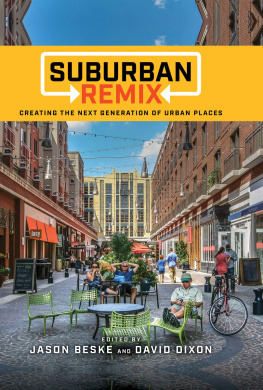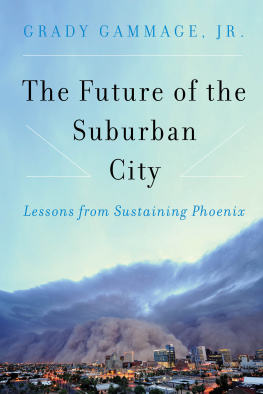
The experience of suburban modernity
STUDIES IN
POPULAR
CULTURE
General editor: Professor Jeffrey Richards
Already published
Christmas in nineteenth-century England
Neil Armstrong
Healthy living in the Alps: the origins of winter tourism in Switzerland, 18601914
Susan Barton
Working-class organisations and popular tourism, 18401970
Susan Barton
Leisure, citizenship and working-class men in Britain, 18501945
Brad Beaven
Leisure and cultural conflict in twentieth-century Britain
Brett Bebber (ed.)
British railway enthusiasm
Ian Carter
Railways and culture in Britain
Ian Carter
Time, work and leisure: Life changes in England since 1700
Hugh Cunningham
Darts in England, 190039: a social history
Patrick Chaplin
Holiday camps in twentieth-century Britain: packaging pleasure
Sandra Trudgen Dawson
History on British television: constructing nation, nationality and collective memory
Robert Dillon
The food companions: cinema and consumption in wartime Britain, 193945
Richard Farmer
Songs of protest, songs of love: popular ballads in eighteenth-century Britain
Robin Ganev
Women drinking out in Britain since the early twentieth century
David W. Gutzke
The BBC and national identity in Britain, 192253
Thomas Hajkowski
From silent screen to multi-screen: a history of cinema exhibition in Britain since 1896
Stuart Hanson
Juke box Britain: Americanisation and youth culture, 194560
Adrian Horn
Popular culture in London, c. 18901918: the transformation of entertainment
Andrew Horrall
Popular culture and working-class taste in Britain, 193039: a round of cheap diversions?
Robert James
Amateur film: meaning and practice, 19271977
Heather Norris Nicholson
Films and British national identity: from Dickens toDads Army
Jeffrey Richards
Cinema and radio in Britain and America, 192060
Jeffrey Richards
Looking North: Northern England and the national imagination
Dave Russell
The British seaside holiday: holidays and resorts in the twentieth century
John K. Walton
The experience of suburban modernity
How private transport changed interwar London
MICHAEL JOHN LAW
Manchester University Press
Manchester and New York
distributed in the United States exclusively by
Palgrave Macmillan
Copyright Michael John Law 2014
The right of Michael John Law to be identified as the author of this work has been asserted by him in accordance with the Copyright, Designs and Patents Act 1988.
Published by Manchester University Press
Altrincham Street, Manchester M1 7JA, UK
and Room 400, 175 Fifth Avenue, New York, NY 10010, USA
www.manchesteruniversitypress.co.uk
Distributed in the United States exclusively by
Palgrave Macmillan, 175 Fifth Avenue, New York,
NY 10010, USA
Distributed in Canada exclusively by
UBC Press, University of British Columbia, 2029 West Mall,
Vancouver, BC, Canada V6T 1Z2
British Library Cataloguing-in-Publication Data
A catalogue record for this book is available from the British Library
Library of Congress Cataloging-in-Publication Data applied for
ISBN 978 0 7190 8919 0
First published 2014
The publisher has no responsibility for the persistence or accuracy of URLs for any external or third-party internet websites referred to in this book, and does not guarantee that any content on such websites is, or will remain, accurate or appropriate.
Typeset in Adobe Garamond by
Servis Filmsetting Ltd, Stockport, Cheshire
STUDIES IN
POPULAR
CULTURE
There has in recent years been an explosion of interest in culture and cultural studies. The impetus has come from two directions and out of two different traditions. On the one hand, cultural history has grown out of social history to become a distinct and identifiable school of historical investigation. On the other hand, cultural studies has grown out of English literature and has concerned itself to a large extent with contemporary issues. Nevertheless, there is a shared project, its aim, to elucidate the meanings and values implicit and explicit in the art, literature, learning, institutions and everyday behaviour within a given society. Both the cultural historian and the cultural studies scholar seek to explore the ways in which a culture is imagined, represented and received, how it interacts with social processes, how it contributes to individual and collective identities and world views, to stability and change, to social, political and economic activities and programmes.This series aims to provide an arena for the cross-fertilisation of the discipline, so that the work of the cultural historian can take advantage of the most useful and illuminating of the theoretical developments and the cultural studies scholars can extend the purely historical underpinnings of their investigations.The ultimate objective of the series is to provide a range of books which will explain in a readable and accessible way where we are now socially and culturally and how we got to where we are.This should enable people to be better informed, promote an interdisciplinary approach to cultural issues and encourage deeper thought about the issues, attitudes and institutions of popular culture.
Jeffrey Richards
Contents
List of tables
List of figures
General editors introduction
Michael John Law is a man with a mission to rescue interwar suburbia from the enormous condescension of contemporary intellectuals who made the term suburban a byword for dullness, narrowness and emptiness. Drawing on a rich and varied range of evidence, including statistics, reports, newspaper and magazine journalism, popular fiction, newsreels, documentaries and feature films, he advances the proposition that the London suburbs were in the vanguard of modernity, particularly when it came to travel, transport and technology.
The car is the principal focus of his analysis. Endorsing the verdict of Autocar magazine from 1938 that a car was an indispensable adjunct of middle class life, he charts the growth and pattern of car ownership as suburbanites increasingly used cars for commuting to work and gaining access to leisure. He traces the development of new arterial roads, exploring the debate about the transformative effect this had on the landscape. He examines the culture of speed that grew up with the car and the debate over the introduction of restrictions on motoring as car accidents hit the headlines. He discusses the motorisation of consumption, as the arterial roads attracted the construction of shopping parades, garages and car showrooms, public houses, cinemas and that distinctive interwar phenomenon, the roadhouse, a glamorous combination of restaurant, dance hall, swimming pool and nightclub, which could be reached only by car.


